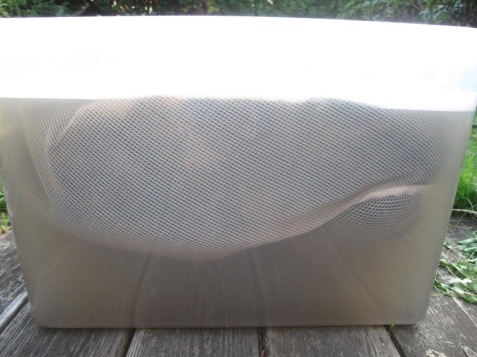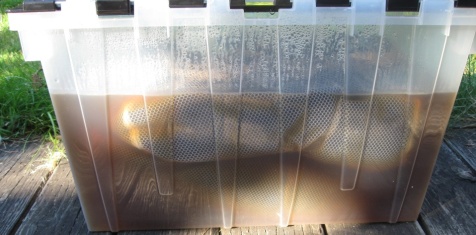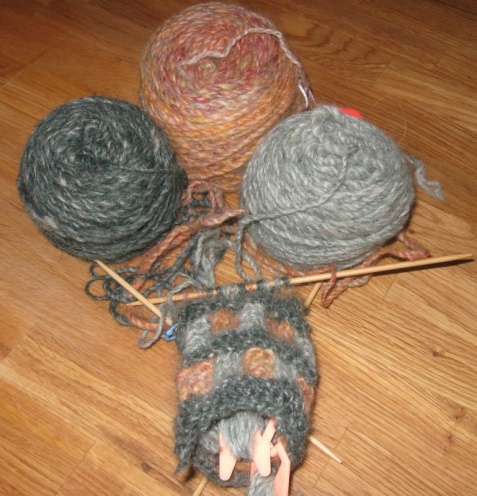I realize I haven’t posted in ages! For that, dear readers, I apologize. It’s not that I haven’t been busy – I have! I just haven’t had the energy to focus on something specific to post about. Therefore, I am going to attempt to get it together to post today about a couple different topics, but mostly about washing fleece.
This summer, I have been awash in fleece (sorry about the bad pun ;)). I have purchased two alpaca fleeces and been given another couple fleeces by a local farmer who posted to my spinning group. This windfall of raw, dirty and smelly fiber has once again set me thinking about more efficient and environmentally friendly ways of cleaning it. My usual method, over the years, has involved my clothes washer, very hot water and multiple washes and rinses. Being an ecologist, I am almost always permanently guilty about using unnecessary resources, in this case lots of water and electricity to heat that water. My old washer uses about 33 gallons per load and usually I need about six washes/rinses to clean a fleece. That is a lot of water! Recently, I tried out Kookaburra wool scour, which is a strong lanolin remover. However, this method also needs extremely hot water (turn up the hot water heater all the way up) to work properly and of course doesn’t work on alpaca, which has no lanolin.
Therefore, this summer myself and my neighbor, spinninglizzy, have been experimenting with alternative ways of washing fleece. I’ll start with alpaca – these adorable critters love to roll around in the dirt. Their fleece, while marvelously soft is also totally filled with tiny dirt particles that are very hard to get out. Multiple washes are usually necessary with more and more particles falling out to the bottom to properly clean a fleece. This can take up to 8 washes as the particles are really stuck to the fleece. I decided to run an experiment to see what would happen if I filled a tub with hot soapy water and let the fleece soak in it for 3-4 days. I thought the soap would coat the fleece and eventually the particles would fall out.
This is what my bin full of alpaca looked like on day three:

washing alpaca
Note how the color gets darker on the bottom. When I removed the fleece, there was a pretty good layer of dirt settled out on the bottom. I then washed the fleece very hot water and soap and rinsed a couple times and the fleece seemed very clean afterwards. This method does seem to help remove many of the fine particles and cuts down on the number of times the fleece has to be washed. Of course, since I’ve only done this once, I can’t say for sure that it works – I could have gotten a cleaner than average fleece.
Next, we move on to sheep. There was a great article in Spin-off Magazine last year by Judith MacKenzie McCuin about different methods of washing fleece and one she introduced me to is the FSM (fermented suint method). This involves taking a dirty fleece, and leaving it in a bin of cold water for about a week. During this time, the suint, which is a substance secreted by sheep that acts like a natural shampoo and cleans the fleece when it rains, ferments. This acts like a natural cleanser and takes all the dirt and lanolin out of the fleece. Unfortunately, as you can imagine, it smells HORRIBLE. The sentence that instantly comes to mind is concentrated sheep poop.
Spinninglizzy has a great post on her blog about this method, which she has also been trying out this summer: http://spinninglizzy.wordpress.com/2009/08/26/it-fell-off-the-back-of-a-truck/
So basically, you leave the fleece in for a week. You take it out and put it in another bin of cold water and rinse repeatedly until the water is clear. At this point, it is very clean but it still smells awful. So I then put it into some very hot water and soap, followed by a rinse or two with Kookaburra wool scour which smells very strongly of eucalyptus (well at least that’s what I think it is) and imparts that more pleasant odor to the wool. The problem is that I only have one bin and therefore can only clean about two-three pounds of wool at one time so I have to do multiple loads for a fleece. So the next load, you just put directly into the already disgusting and fermented water, and it only takes about three days to clean. Rinse and repeat. Apparently you can use the same fermented water for multiple fleeces, although I’ve used it for two fleeces and I think I’m going to have to get rid of it soon due to the stench. Maybe when it starts raining again, I can dump it out in a secluded corner of the yard where it will get washed away….
In any case, bad smells aside, I’m very happy with this method. It doesn’t use a lot of hot water, it really does clean the fleece thoroughly and this winter, I might try laying out the fleece on the lawn to let the rains wash the smell out. That would really be sustainable! Here’s a photo of my bin after the first week:

Washing wool
Ok, enough about washing fleece. Here’s a photo of my latest project: Gloves using the three colors of Icelandic roving I was given a few months ago (see my earlier post about this). I’ve spun up all the yarn and I’m very happy with the way the colors turned out. I just finished the ribbing and now I’m moving on to the pattern. I’ll give an update soon!

Icelandic gloves